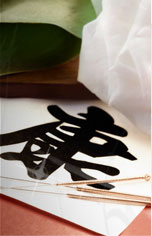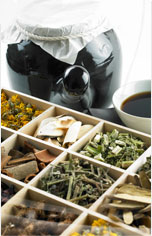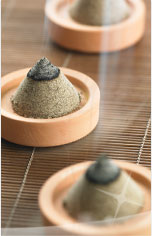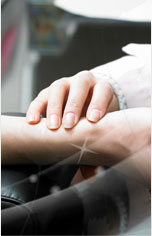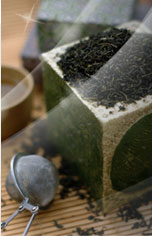| |
Acupuncture and Chinese Herbs for Endometriosis |
|
Endometriosis is a gynecological medical condition in which endometrial-like cells appear and flourish in areas outside the uterine cavity. The uterine cavity is lined by endometrial cells, which are under the influence of female hormones. These endometrial-like cells in areas outside the uterus (endometriosis) are influenced by hormonal changes and respond in a way that is similar to the cells found inside the uterus. Common sites of endometriosis include the cervix, vaginal-rectal space, ovaries, fallopian tubes, colon and bladder wall.
 It has been estimated that endometriosis occurs in roughly 3-10% of women. Although endometriosis is typically diagnosed during the reproductive years (age 25 to 35), the condition probably begins about the time that regular menstruation begins. A woman who has a mother or sister with endometriosis is six times more likely to develop endometriosis than women in the general population1. Other risk factors include:
- Never giving birth to a child
- Starting menstruation at an early age
- Having menstrual cycles shorter than 27 days
- Heavy, painful menstrual cycles lasting longer than 7 days
- Having a medical condition that prevents the normal passage of menstrual flow
|
| |
Endometriosis in TCM
According to the theories of Traditional Chinese Medicine (TCM), endometriosis is best described as Blood stasis syndrome with formation of abdominal lumps. TCM views the body as being traversed by a network of channels like the circulatory system described in Western medicine. These channels are contiguous and follow very specific pathways, carrying Qi (the vital energy of the body) and Blood to all the organs and tissues of our body, providing warmth and nourishment. Ideally, Qi and Blood circulate freely throughout the system. Any blockage or reduction in flow creates a condition known as stasis. In women, Blood stasis can lead to symptoms such as painful periods, pelvic pain, heavy bleeding, and infertility.
Blood stasis is caused by many external and internal factors that occur during and around the time of menstruation. One primary cause of Blood stasis in the lower abdomen is Cold. Coldness inhibit proper circulation of Qi and Blood, resulting in a physical environment which promotes endometriosis. The two greatest sources of Cold are climate and diet. Women often go out in cold weather without being warmly dressed, commonly exposing the legs, neck and head to a chill. This translates to a cooling of the entire system, in the same way a radiator works to cool down a car engine. Diet is another significant source of Cold. Consumption of cold foods and beverages cools down the abdomen, slowing the circulation of Qi and Blood, and creating conditions of stagnation that can lead to the symptoms of endometriosis. In order to relieve symptoms such as painful periods, it is important to consume warm foods and beverages, and to avoid cold foods and beverages.
Physical trauma and emotional stress also play key roles in women’s reproductive health. Physical trauma, such as pelvic surgery, can interrupt the proper flow of Qi and Blood through the abdomen, leading to stagnation. Emotional strain is also a common cause of Blood stasis. For example, when we experience stress, we feel tense and our neck muscles tighten up. Though we might feel the sensation in the neck muscles only, this tightening is occurring throughout the body, irresistibly constricting Qi and Blood flow. Over time, chronic stress leads to stagnation and pain.
NOTE: The names of organs are capitalized when referring to the entire, functional organ systems in TCM perspective: Liver, Blood, etc. The names of organs are lower-cased when referring to the distinct, biomedical organs: liver, blood, etc.
|
| |
TCM Treatment for Endometriosis
TCM treatment plan depends on the pattern differentiation diagnosis, based on the presenting signs and symptoms of individual patients and the underlying imbalances as the root of the conditions. Both acupuncture and Chinese herbs can work to reduce the pain, breakup the old stagnant blood, encourage fresh red flow, and promote hormonal balance. Patients with mild endometrial symptoms may use TCM alone to heal naturally from the effects of endometriosis. More severe cases may require both Western and Chinese medicine to have the best prognosis for long-term cessation of symptoms.
Acupuncture
Acupuncture promotes the release of endorphins and other chemicals in the body which help heal and manage pain. Acupuncture also enhances the immune and endocrine systems by stimulating the autonomic nervous system to help eliminate stray endometrial cells; restores renal and adrenal function to correct irregular cycles; and helps detoxify the liver to metabolize excess estrogen that feeds endometriosis.
Acupuncture treatments mainly focus on alleviating the symptoms of endometriosis by improving circulation of Qi and Blood. It is believed that when Qi and Blood are out of balance, blocked, or stagnated, illness and pain result. By placing fine sterile needles into the areas of disharmony, acupuncture will restore the balance and allow Qi and Blood to flow freely again, thereby alleviating the symptomatic problems.
Each acupuncture point has its own therapeutic importance in the treatment of endometriosis, depending on the TCM diagnosis of the patients. Besides the acupuncture points on the lower abdomen, the points on the hands, arms, legs, feet, and back can be used in the treatment of endometriosis.
|
|
|
The Goals of TCM Treatments for Endometriosis
- Alleviating pain by increasing blood circulation
- Removing Blood Stasis and dissolving masses to shrink endometriosis and prevent recurrence of the condition
- Enhancing the immune and endocrine systems to help eliminate stray endometrial cells
- Relieving stress and correcting disruptions in the flow of Qi to strengthen and balance general health
- Warming the uterus and regulating menstrual cycles to help ovulation and enhance fertility
- Minimizing undesired side effects and eliminating accumulated toxicity from medication and invasive procedures
|
| |
|
Electro-acupuncture and/or moxibustion can enhance the effect of acupuncture treatment. Electro-acupuncture uses electric impulse stimulation through the acupuncture needles in affected areas and is often used for more severe pain conditions of endometriosis. It is a pain-free procedure with a small amount of throbbing and vibration in the affected area.
Moxibustion is used to create heat and therapeutic effects as a stand-alone or an additional treatment to acupuncture in certain types of endometriosis and pelvic pain conditions. Moxibustion creates deep warmth in the applied area, increases blood circulation throughout the pelvic cavity, and promotes healing.
The treatment of endometriosis with acupuncture usually requires a commitment of enough time to rebalance the body’s systems. At least three months of consistent treatment, 1-2 times per weeks, is generally required to treat the root cause of endometriosis. The patient with infertility because of endometriosis may need consistent treatments for six months or longer. This will vary from one woman to another, and will depend on the severity of the disorder. Some women will see a reduction in their symptoms right away, while others may take a longer time. Stress levels, lifestyle, and general health are important factors involved in response time.
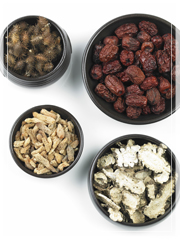
Chinese Herbal Medicine
Chinese herbs help reduce pain and shrink endometriosis. Chinese herbs target the pelvic region to increase circulation and to eliminate the growth and recurrence of endometriosis by removing Blood stasis and dissolving masses. They are also used to rebalance hormones, heal tissue, and help strengthen the immune system. Many studies have shown the therapeutic effects of Chinese herbal medicine in the treatment of endometriosis.2
Chinese herbs are usually used in combination of 2 to 30 herbs and are customarily prescribed for each patient. Therefore, it is common to have different herbal prescriptions from patient to patient in endometriosis condition.
Herbs can be administered to a patient in many forms. Raw herbs can be taken as a brewed tea form. This herb tea form is strong and quick acting; however, it takes time for cooking and preparation and the taste can be quite strong. The herbs can also be consumed in many other forms such as powder, capsule, pill, topical and tincture. Herbs possess many strengthening and therapeutic effects because of their content of various nutrients and vitamins, which are essential to the body. While Chinese herbal medicine can be very potent, it may take a few weeks to months before the full effects are noticed.
Nutritional Advice
TCM believes that proper nutrition is one of the most important foundations to health and disease prevention. While not a cure for endometriosis, right diet helps keep the hormone levels balanced, reducing pain and inflammation. In endometriosis, patients are generally advised to avoid smoking, recreational drugs, caffeine, refined sugar, cold raw foods, and dairy products. Increased intake of green vegetables and seaweed are also advised. Following guidance is recommended to prevent and reduce further irritation, inflammation and other symptoms of endometriosis.
What to Eat
- Fiber-rich fruits, vegetables, legumes, whole grains
Estrogen clings to bile acids that move through your intestines, and the hormone is removed from the body during the digestion process. Fibers bind to the bile acids and encourage the flushing process, thus lowering the estrogen levels. Examples of fiber-rich foods are: fruits such as raspberries, pears, apples, strawberries, bananas, oranges, figs, raisins; vegetables such as artichoke, peas, broccoli, potatoes, carrots, tomatoes; legumes, nuts, and seeds such as almonds, beans, split peas, pecans, pistachio nuts; and whole grains such as brown rice, oatmeal, barley, rye.
- Cruciferous vegetables
Cruciferous vegetables such as broccoli, Brussels sprouts, cabbage, cauliflower, Chinese cabbage, collards, kale, mustard, radish, rutabaga, and turnip are high in vitamin C and soluble fiber and contain a chemical known as indole-3-carbinol (C9H9NO), which improves the body's ability to metabolize excess estrogen.
- Seaweeds
In Chinese herbal medicine, seaweeds such as Kun Bu and Hai Zao are used to promote blood circulation and eliminate phlegm stasis. In Korea, seaweeds are known as ‘female’s food’ and often consumed before and after menstruation or childbirth. In recent researches have shown that seaweeds have excellent nutritional qualities, and brown seaweeds in particular, can prevent the formation of blood clots, lower cholesterol and halt the growth of tumors. Studies in animals showed that a significant lowering of fats in the liver occurred when seaweeds were eaten, which has strengthened the belief that seaweeds can be a valuable part of a good liver detoxification.3
- Omega-3 Fatty Acids
Studies have shown that omega-3 reduces the symptoms of endometriosis.4 Omega-3 fatty acids can alleviate menstrual cramping by promoting blood circulation, preventing the formation of blood clots, and reducing excess prostaglandin, the natural agent of the body causing inflammation and cramping of endometriosis. Cold-water oily fish such as salmon, herring, mackerel, anchovies and sardines are excellent source of omega- 3 fatty acids. Fruits, vegetables, seeds and nuts such as flaxseed oil, chia, kiwi, black raspberry, lingo berry (cowberry), hemp seeds, pumpkin seeds, safflower seeds, walnuts, pecans, hazelnuts, and olive oil are another source of omega-3 fatty acids.
What to Avoid
- Sweets and other foods with high glycemic index
These foods will raise insulin levels, increase estrogen dominance, and may cause endometriosis. It is also imperative to eat a breakfast containing good quality protein, fats, and carbohydrates in combination to avoid hypoglycemic stress–induced cortisol and epinephrine elevations, which will deplete lean muscle via gluconeogenesis and increase the tendency for insulin resistance.
- Alcohol
Alcohol is okay if consumed in moderation. Studies show that women consuming more than five alcoholic drinks per week have a higher risk of breast cancer. This increase is probably because of the effect of alcohol on detoxification of estrogens.
- Caffeine
Studies have shown that caffeine increases production of the estrogen, especially estradiol. Caffeine also interferes with the liver’s ability to metabolize excessive estrogen in the body, causing an increase in serum level estrogen. Organic coffee in moderation (1 or 2 cups per day) is safe.
|
|
|

